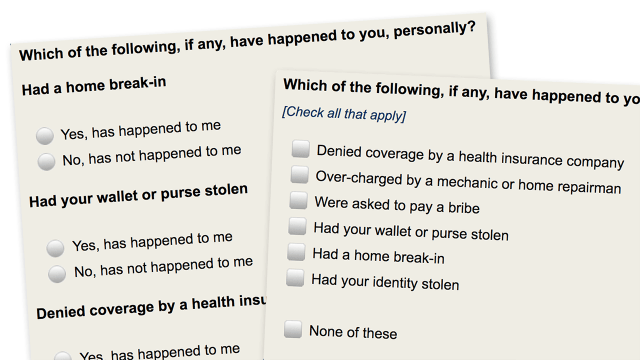
Anyone who has taken a survey has likely been given the option to “check all that apply” when answering a question. The instruction is widely used in data collection because of its ease and efficiency. But when designing an online survey questionnaire, there is more than one way to ask a respondent to select which options in a series apply to them.
A pollster can show respondents a list and ask them to select all that apply, or the pollster can ask separately about each option. The two methods do not always yield identical results. Studies have repeatedly indicated that more survey respondents endorse (answer “yes” to) each option under the latter approach, known as “forced-choice,” sometimes resulting in very different estimates. However, previous studies have not been clear on which question format produces the more accurate estimates. 1
Using its national online American Trends Panel (ATP), Pew Research Center conducted a large, randomized experiment comparing these two question formats. The experiment was part of a survey conducted July 30-Aug. 12, 2018, among 4,581 U.S. adults. Respondents were asked whether they or someone in their immediate family had experienced various undesirable events (e.g., treated for addiction to drugs or alcohol, or lost a home to foreclosure). The study randomly assigned half the respondents to answer using a select-all-that-apply list while the other half answered a series of forced-choice “yes/no” questions.
The challenge of this sort of research is in determining which measurement gets it more “right.” The research that undergirds this experiment shows that, when it comes to undesirable but relatively common events, respondents are more likely to underreport their actual experiences than to overreport something they haven’t experienced. For example, it’s more plausible that someone treated for addiction would decline to tell a pollster about their experience than it is that someone who has never been treated for addiction would report that they had been. For the purposes of this study, then, higher victimization estimates are thus presumed to reflect more accurate responses.2
The new study found compelling evidence that forced-choice questions yield more accurate results than select-all-that-apply lists. In the randomized experiment, panelists were first asked, “Which of the following, if any, have happened to you, personally?” and were shown six items. Later in the questionnaire, they were then asked, “Which of the following, if any, has happened to you OR someone in your family?” and were shown a different set of six items. Each panelist was randomly assigned to receive both questions either as select-all-that-apply lists or as forced-choice batteries. The study found that victimization estimates were consistently higher using the forced-choice format versus selecting all that apply. For example, the estimated share of U.S. adults saying that they had personally been denied coverage by a health insurance company was 19% using the forced-choice format versus 13% using select-all-that-apply. The estimated share of U.S. adults saying that they or someone in their immediate family had lost a job and struggled to find another one was 63% using the forced-choice format versus 51% under select-all-that-apply. On average, victimization estimates were 8 percentage points higher with individual forced-choice questions than with a checklist.
While question format clearly affected endorsement rates, it had little effect on which items were most or least endorsed. The arrangement of most to least endorsed items is identical or highly similar between forced-choice and select-all-that-apply formats, with differences being almost entirely within the margins of sampling error. This implies that if only the rank order is of interest, either format will do.
A companion analysis using the Center’s ATP archive examined whether primacy effects, a type of measurement error, were larger for select-all-that-apply questions than forced-choice ones. Primacy effects refer to the tendency for some respondents to endorse whichever item occurs at the top of the list more often than items below. An example of a primacy effect in archival ATP data is when respondents were shown a list of personal traits and asked to select the ones that described them well. The order in which the traits were listed varied across respondents. A total of 57% of respondents endorsed whichever trait was listed first, while only 42% of respondents endorsed the trait listed last – an order effect of 15 percentage points. Other researchers have examined whether such order effects are larger for checklists than for forced-choice formats, and the findings have been mixed.3
Across 21 ATP surveys conducted between November 2015 and August 2018, the average order effect observed for select-all-that-apply questions was 3 percentage points, compared to 0 percentage points for forced-choice questions. While this suggests that primacy effects may be slightly larger for checklists than forced-choice questions, the overall relationship is weak. The archival analysis is also much more tentative than the aforementioned experimental analysis because in the archival data the question formats were not tested in a head-to-head fashion. There are several other potential explanations for differences observed, such as certain question topics being both more prone to primacy effects and being more likely to be fielded as select-all-that-apply questions. Another factor could be the tendency for select-all-that-apply questions to have more answer choices due to having more space. The study’s findings regarding differences in items that were endorsed most or least and primacy effects are consistent with previous studies.
Based on the results of these analyses, Pew Research Center has adopted a policy of using a forced-choice format instead of a select-all-that-apply list in its online surveys whenever possible.
Pros and cons of different question formats
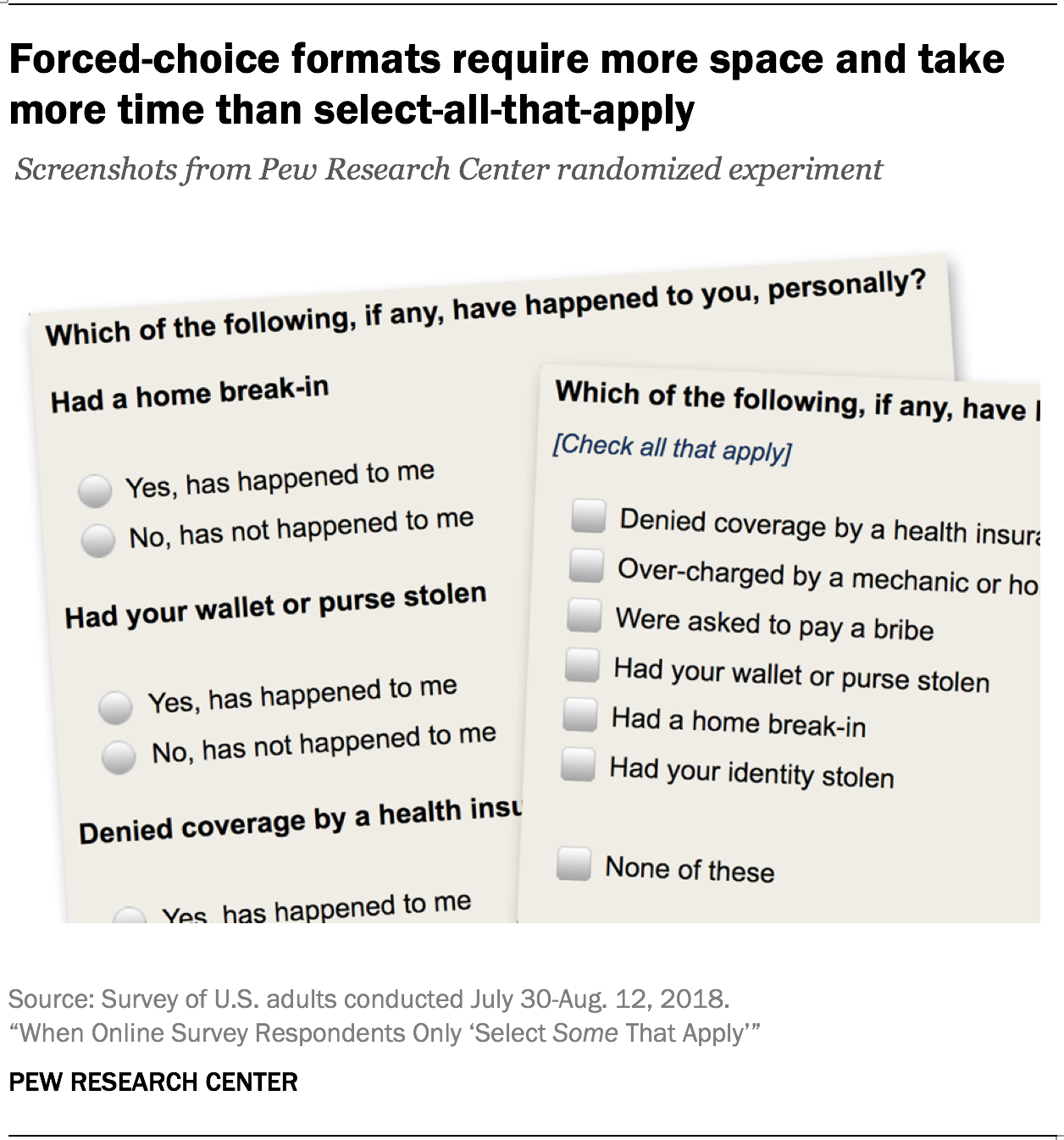 Select-all-that-apply questions are formatted succinctly and can thus take up only a single screen. By contrast, forced-choice batteries require a separate question for each item, which is more likely to require respondents to either scroll down or click through several screens. This increases the amount of time it takes for respondents to get through these questions, which can be burdensome.
Select-all-that-apply questions are formatted succinctly and can thus take up only a single screen. By contrast, forced-choice batteries require a separate question for each item, which is more likely to require respondents to either scroll down or click through several screens. This increases the amount of time it takes for respondents to get through these questions, which can be burdensome.
However, select-all-that-apply questions ask respondents to consider all the options at the same time. Responding accurately with respect to each item in the list can require a fair amount of discipline from respondents. Those lacking enough motivation may “satisfice,” or respond only in a satisfactory manner rather than in the most accurate way possible. When presented with a sizeable array of options, respondents may select only some that apply rather than all.
Forced-choice questions, as their name implies, force the respondents to provide a separate answer for each item, one by one. This format encourages respondents to more deeply consider each option, especially as they are not simultaneously juggling all the other options. Prior studies have shown that respondents are more likely to endorse options when presented to them as a forced-choice compared to when the same options are presented as a select-all-that-apply.
Proponents of forced-choice questions argue that this increased rate of endorsement is a sign that the format encourages deeper cognitive processing, or salience.4 However, it is also possible that this format is much more susceptible to acquiescence response bias, which is when respondents tend to endorse any assertion made in a question, regardless of its content.5 If satisficing is the larger problem, then estimates derived from select-all-that-apply formats could be lower than they should be (and thus more inaccurate). However, if acquiescence bias dominates, then estimates derived from forced-choice formats may be artificially inflated.
One proven way of dealing with acquiescence bias is to use more direct, construct-specific wording, where the response categories are tailored to be directly relevant to the question being asked.6 For example, a question about whether respondents have or have not done a range of activities in the past year can spell out the response options as “Yes, have done this” and “No, have not done this” rather than merely “Yes” and “No.”7
Reporting of undesirable experiences is higher with forced-choice questions than select-all-that-apply
Endorsement rates – the share of survey respondents who answer “yes” to an item – tend to be higher with a forced-choice format than with select-all-that-apply. Are the higher endorsement rates for forced-choice questions caused by respondents answering the items with greater care, or with greater acquiescence?
To answer this question, Pew Research Center conducted an experiment on the American Trends Panel. Panelists were first asked, “Which of the following, if any, have happened to you, personally?” and were shown six items. Later in the questionnaire, they were then asked, “Which of the following, if any, has happened to you OR someone in your family?” and were shown a different set of six items. Each panelist was randomly assigned to receive both questions either as select-all-that-apply lists or as forced-choice batteries. Panelists who were shown the select-all-that-apply list were also given the option to check a box at the bottom of the list stating that none of the options applied to them.8 Panelists who were given forced-choice batteries were also given construct-specific wording for their answer choices; that is, rather than “Yes” and “No,” panelists chose between “Yes, has happened to me [or my family]” and “No, has not happened to me [or my family].”
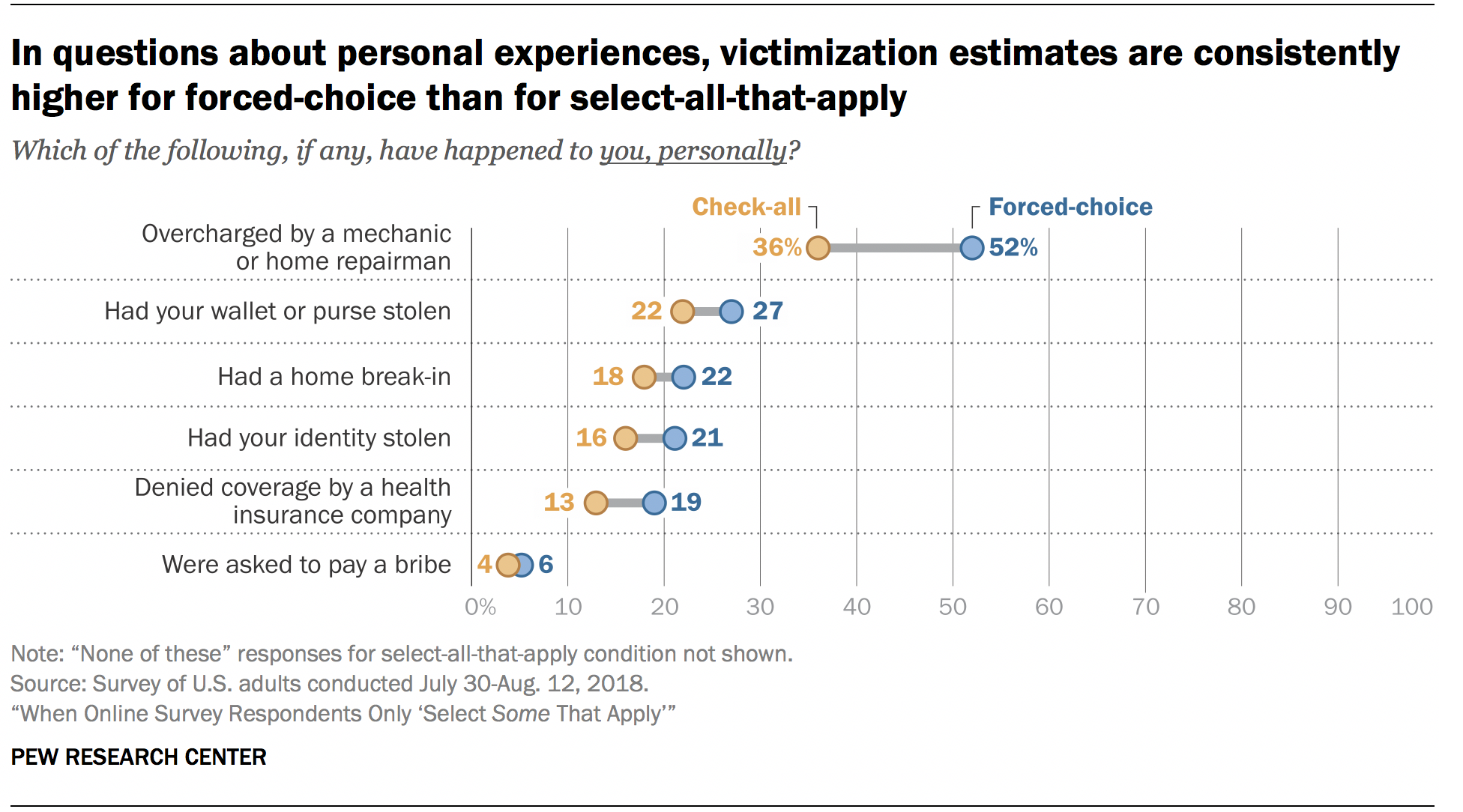
Across all twelve items, endorsement rates were higher for the forced-choice format than for select-all-that-apply. For example, 19% of forced-choice respondents said that they had personally been denied coverage by a health insurance company, compared with 13% of select-all-that-apply respondents. Similarly, 63% of forced-choice respondents said that they or someone in their family had lost a job and struggled to find another one, compared with only 51% of select-all-that-apply respondents. The largest difference came from asking if respondents had personally been overcharged by a mechanic or home repairman, with 52% in the forced-choice condition reporting the experience versus 36% in the select-all-that-apply condition – a 16 percentage point difference.
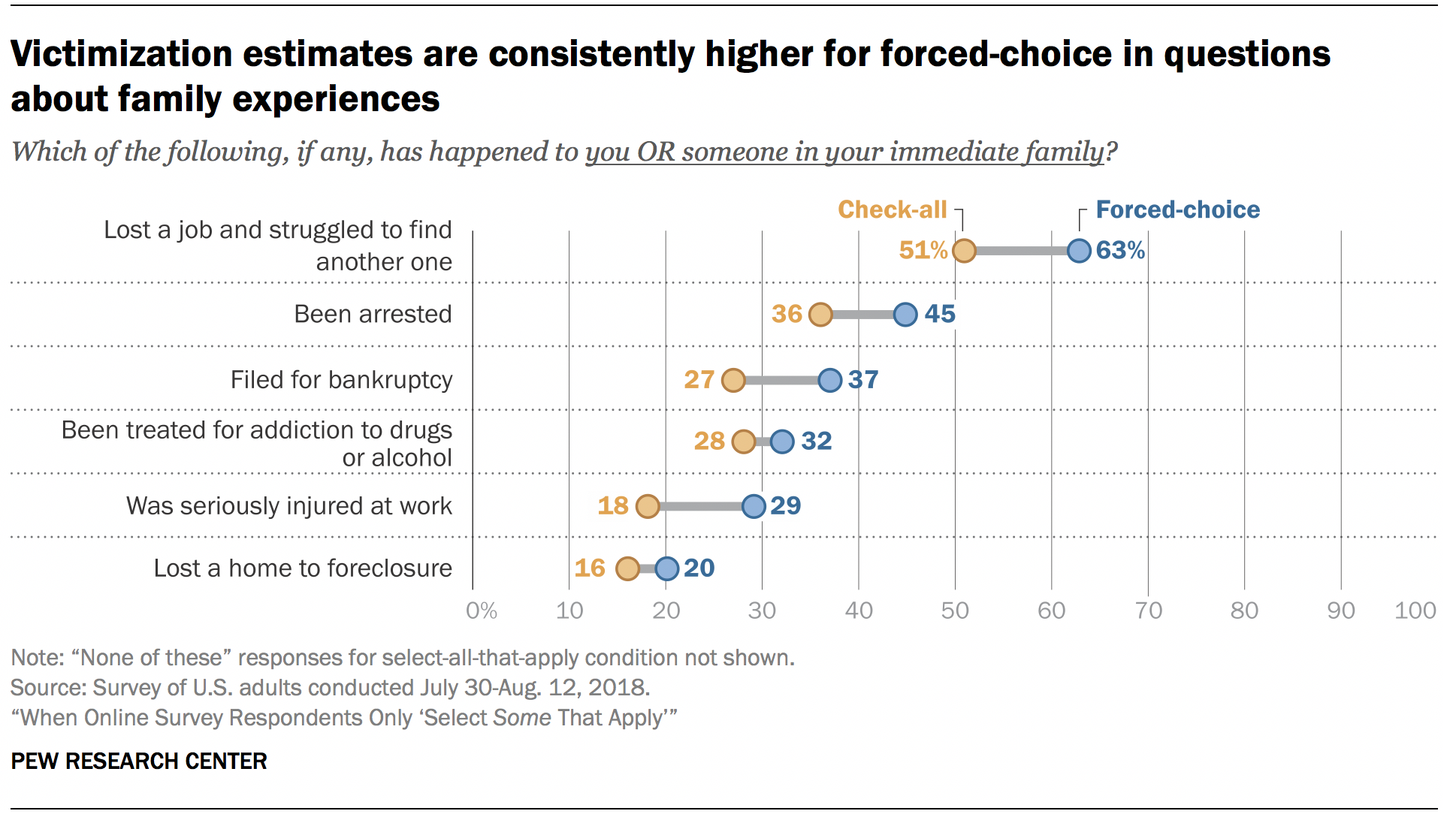
Acquiescence response bias occurs when it is easier or more socially desirable to endorse a response option rather than do the opposite. Respondents in this experiment were not expected to be susceptible to carelessly reporting potentially embarrassing or disheartening events, nor was there any social incentive to do so.9 Factors that usually drive acquiescence should in this case discourage endorsement. Regardless, forced-choice endorsement rates were higher than those for select-all-that-apply by an average of 8 percentage points across all twelve items. This tells us that the estimates from the forced-choice format are more accurate, whereas the checklist format is more prone to respondents only selecting some that apply.
Forced-choice and select-all-that-apply questions yielded similar rank orders of endorsement
For some applications, having accurate estimates for each individual item in a battery or list is less important than having an accurate ranking of which items were the most to least endorsed. When asked which of a series of events had happened to them personally, the question format made no difference in the rank order. Being overcharged by a mechanic or home repairman was the most reported event across both forced-choice and select-all-that-apply conditions, while being asked to pay a bribe was the least reported event, with the rank order of all other items in between agreeing regardless of question format.
For events that had happened to respondents or someone in their families, filing for bankruptcy and being treated for alcohol or drug addiction switch positions between the two experimental conditions. However, the ranking switch is arguably of minor consequence at best, with 27% reporting filing for bankruptcy and 28% reporting addiction treatment under select-all-that-apply, compared to 37% and 32% respectively under forced-choice.
A similar experiment conducted earlier with the American Trends Panel appears to challenge this at first glance. In an ATP survey of 4,867 U.S. adults conducted Sept. 14-28, 2017, respondents were randomly assigned to answer a battery of questions using a forced-choice or select-all-that-apply format. Respondents were asked whether a series of personal traits described them well. In that experiment, the statement “honor and duty are my core values” ranked second using the forced-choice format and fourth using the select-all-that-apply format. There was a gaping 34 percentage point difference for that item between the two conditions (78% with forced-choice, 44% with select-all-that-apply). The precise reason for this large difference is unclear, though the survey literature indicates that vague, attitudinal concepts (like those in the traits experiment) are more susceptible to question formatting effects than concrete, behavioral concepts (like those in the victimization experiment presented earlier).
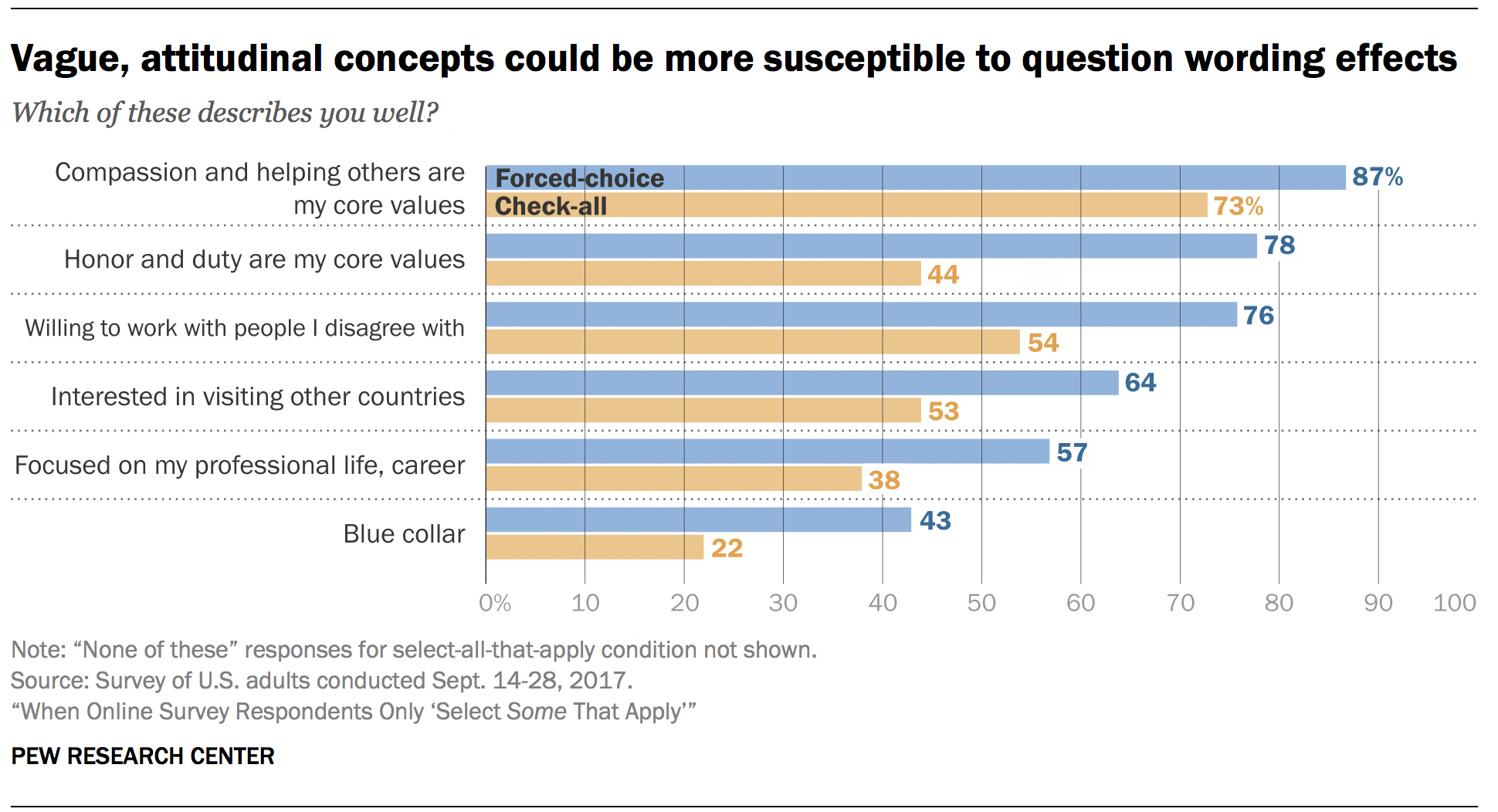
Order effects are generally similar between forced-choice and check-all-that-apply questions
This study also considered whether the size of primacy effects – the tendency to select the first option(s) listed – differs for forced-choice and select-all-that-apply questions. The study specifically considered primacy effects rather than other types of order effects because the surveys considered were all conducted online with respondents reading the questions. (Telephone survey pollsters, by contrast, tend to worry about recency effects because the most recent option spoken by the interviewer is the easiest to recall).
Primacy effects are another indication of people responding in a manner that is merely “good enough.” Respondents being more likely to select whatever item appears closer to the top of a list could indicate that they merely skimmed or did not read the item all the way through. It is standard practice to randomize the order in which respondents see items in order to minimize the impact of primacy effects. However, in some applications, items must be presented in a specific order. The concern is that select-all-that-apply lists, in particular, encourage primacy effects.
The experimental data provides only inconclusive evidence that this is the case. Researchers calculated primacy effects as the signed difference in the endorsement rate between whatever item respondents saw at the first position and whatever item they saw last. For the family victimization battery discussed above, the primacy effects were virtually the same for the forced-choice and select-all-that-apply formats (6.4 and 6.6 percentage points, respectively). The same was true for the personal victimization battery, with the forced-choice format displaying a primacy effect of 2.2 percentage points and the select-all format displaying an effect of 2.6 percentage points.
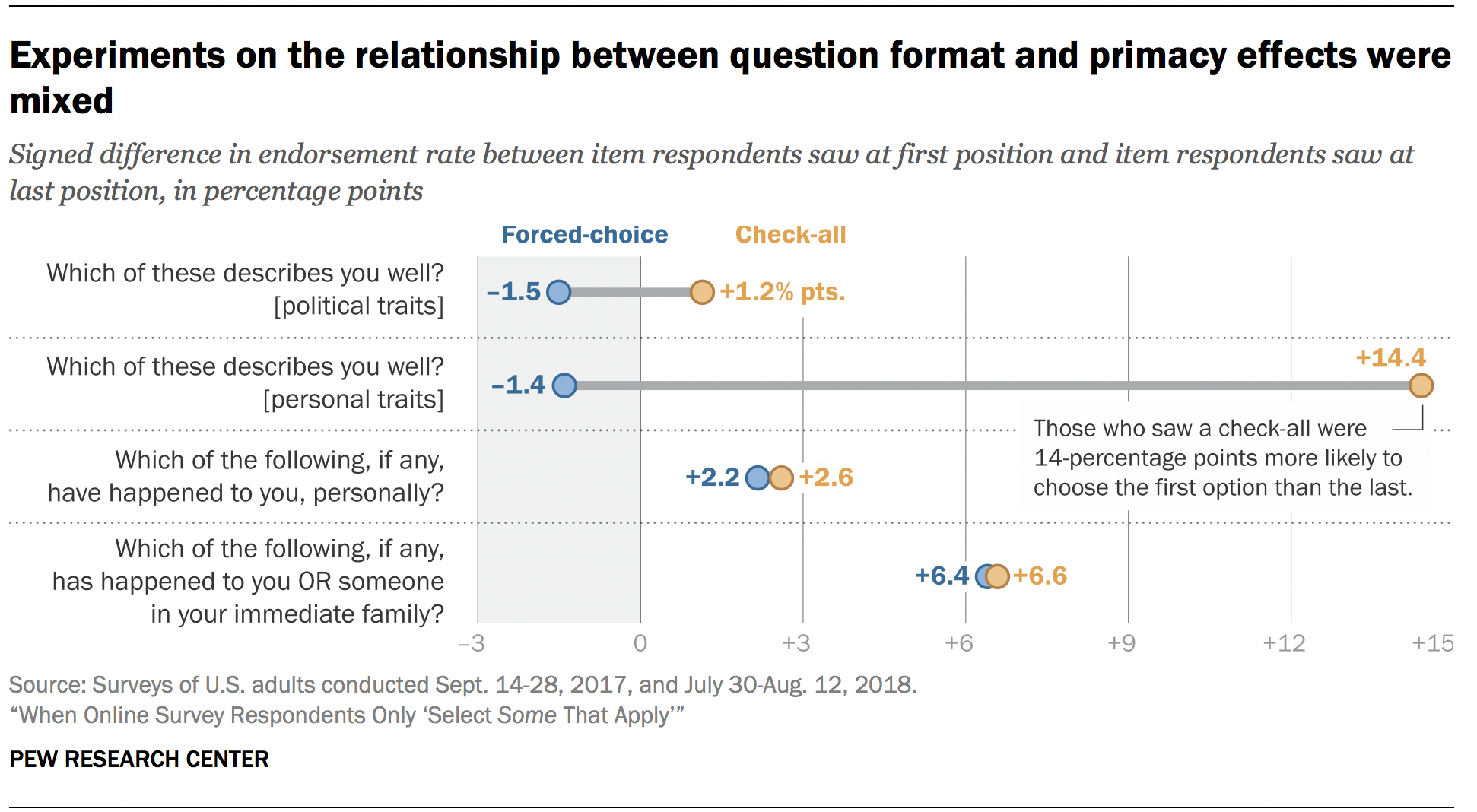
However, for the personal trait battery, the select-all-that-apply format yielded a large, 14.4-point primacy effect, while the forced-choice format showed no primacy effect (-1.4 percentage points). From the same survey, a battery that asked respondents which of a series of political traits described them well – such as being an environmentalist or being a supporter of rights for lesbian, gay, bisexual and transgender (LGBT) people – yielded primacy effects close to zero for both question formats.
Given that the order effects observed in this handful of tests were mixed, researchers sought a larger source of data, albeit a non-experimental one. Researchers scoured 21 surveys conducted on the ATP between November 2015 and August 2018 and identified 40 select-all-that-apply and 25 forced-choice questions that had previously been asked.10
Unlike with the experiments reported above, respondents in these surveys all received the same question format. This means that comparisons between the forced-choice results and select-all-that-apply results could be confounded by factors like differing topics or differing numbers of items. This limitation makes the results from the archival analysis much more tentative than results from the experiments reported above.
In the archival data, the average primacy effect was 0 percentage points among the forced-choice questions examined, while it was 3 percentage points for the select-all-that-apply questions. Taken together, the experimental and observational archival data suggest that forced-choice formatting is, if anything, less susceptible to primacy effects than select-all-that-apply questions, but that effect is usually small and not always consistent.


